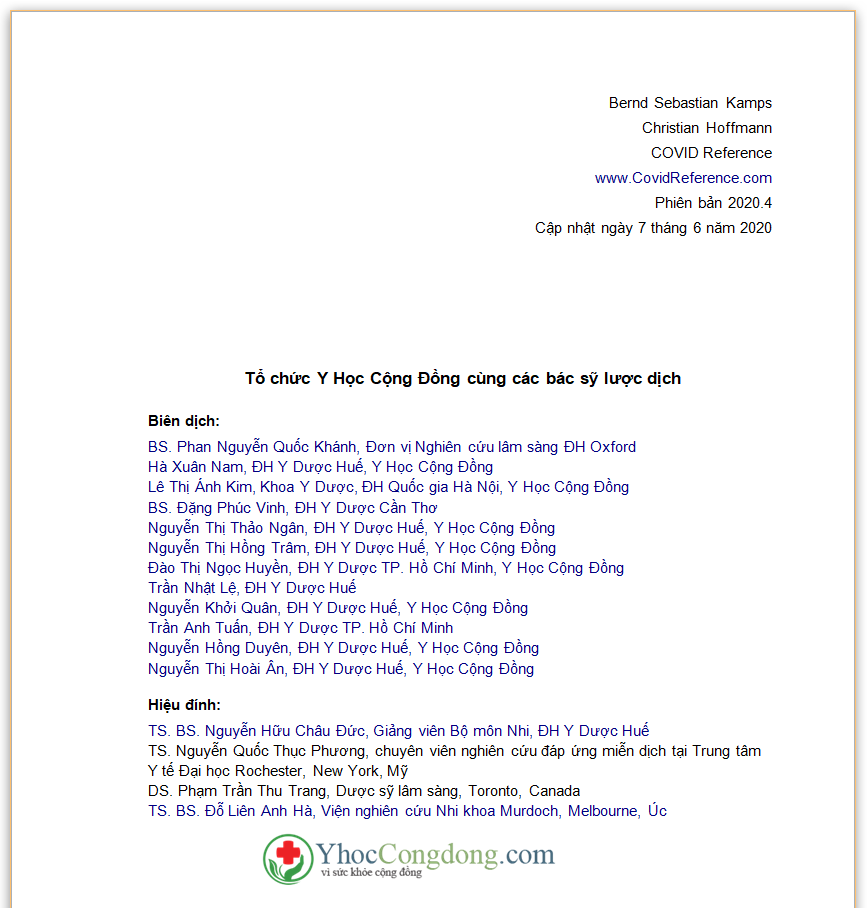Home | TOP 10 | TOP 10 BOOK (PDF)
By Christian Hoffmann &
Bernd S. Kamps
29 August
Immunology
Cox RJ, Brokstad KA. Not just antibodies: B cells and T cells mediate immunity to COVID-19. Nat Rev Immunol. 2020 Aug 24:1-2. PubMed: https://pubmed.gov/32839569. Full-text: https://doi.org/10.1038/s41577-020-00436-4
Antibodies to SARS-CoV-2 may be maintained for only a few months, especially in patients with mild COVID-19. No antibodies, no protection? Relax and remember that memory B cells and T cells may be maintained even if there are no measurable levels of serum antibodies. Rebecca Cox and Karl Brokstad outline our current understanding of B cell and T cell immunity to SARS-CoV-2. Will this immunity last forever? Probably not, as has been shown this week by Kwok-Yung Yuen, Kelvin Kai-Wang To and colleagues: COVID-19 re-infection by a phylogenetically distinct SARS-coronavirus-2 strain confirmed by whole genome sequencing). In this case, the first and the second SARS-CoV-2 episodes were just 142 days apart.
Models
Winkler ES, Bailey AL, Kafai NM, et al. SARS-CoV-2 infection of human ACE2-transgenic mice causes severe lung inflammation and impaired function. Nat Immunol. 2020 Aug 24. PubMed: https://pubmed.gov/32839612. Full-text: https://doi.org/10.1038/s41590-020-0778-2
Michael Diamond, Emma Winkler and colleagues evaluated transgenic mice expressing the human angiotensin I-converting enzyme 2 (ACE2) receptor driven by the epithelial cell cytokeratin-18 (K18) promoter (K18-hACE2). Intranasal inoculation with SARS-CoV-2 resulted in high levels of viral infection in lungs, with spread to other organs. A decline in pulmonary function occurred 4 days after peak viral titer and correlated with infiltration of monocytes, neutrophils and activated T cells. The mice rapidly lost weight after 4 days post-infection (dpi) and began to succumb to disease at 7 dpi. Read more about a massively upregulated innate immune response.
Diagnostics
Wyllie AL, Fournier J, Casanovas-Massana A, et al. Saliva or Nasopharyngeal Swab Specimens for Detection of SARS-CoV-2. N Engl J Med 2020, published 28 August. Full-text: https://doi.org/10.1056/NEJMc2016359
Detecting more SARS-CoV-2 RNA copies in saliva specimens than in nasopharyngeal swab specimens? Finding that a higher percentage of saliva samples than nasopharyngeal swab samples are positive up to 10 days after the COVID-19 diagnosis? Screening 495 asymptomatic health care workers who provided both saliva and nasopharyngeal samples and discovering, to your surprise, more positive results in the saliva samples? That’s what Nathan Grubaugh, Anne Wyllie and colleagues reported in a letter to the NEJM. Read more about fewer direct interactions between health care workers and patients, a possibly lower risk of nosocomial infection and lower demands for personal protective equipment.
Vogels CBF, Brackney D, Wang J, et al. SalivaDirect: Simple and sensitive molecular diagnostic test for SARS-CoV-2 surveillance. medRxiv 2020, posted 4 August. Full-text: https://doi.org/10.1101/2020.08.03.20167791
More information about the previous article (same research group). Here Nathan Grubaugh, Anne Wyllie, Chantal Vogels and colleagues explain how SalivaDirect might improve accessibility, scalability and cost ($1.29-$4.37/sample) of SARS-CoV-2 testing. The test has been granted an emergency use authorization by the U.S. Food and Drug Administration (FDA) on August 15. This paper has not yet been peer-reviewd.
See also the August 15 Yale Newsletter and the info page of the Grubaugh Lab.
Pediatrics
Hurst JH, Heston SM, Chambers HN, et al. SARS-CoV-2 Infections Among Children in the Biospecimens from Respiratory Virus-Exposed Kids (BRAVE Kids) Study. medRxiv 2020, posted 21 August. Full-text: https://doi.org/10.1101/2020.08.18.20166835
Data from the BRAVE Kids study, Matthew Kelly, Jillian Hurst and colleagues describe the clinical and epidemiological characteristics of 382 children and adolescents who had close contact with a SARS-CoV-2-infected individual. Children aged 6 – 13 years were frequently asymptomatic (39%) and had respiratory symptoms less often than younger children (29% vs 48%) or adolescents (29% vs 60%). Compared to children aged 6 – 13 years, adolescents more frequently reported influenza-like (61% vs 39%), gastrointestinal (27% vs 9%; p = 0.002), and sensory symptoms (42% vs 9%), and had more prolonged illnesses [median (IQR) duration: 7 (4, 12) vs 4 (3, 8) days]. The authors also found that SARS-CoV-2-infected children were more likely to be Hispanic (p < 0.0001), less likely to have asthma (p = 0.005), and more likely to have an infected sibling contact (p = 0.001) than uninfected children.
Journal Feature
Mallapaty S. The coronavirus is most deadly if you are older and male — new data reveal the risks. Nature 2020, published 28 August. Full-text: https://www.nature.com/articles/d41586-020-02483-2
The year 2020 is not a good time to be old… and a man. Smriti Mallapathy gives an overview of the stark statistics from the first detailed studies into the mortality risks for COVID-19.
No more articles today. We were busy with the 4th Vietnamese Edition which will be published next week. Page 1:

